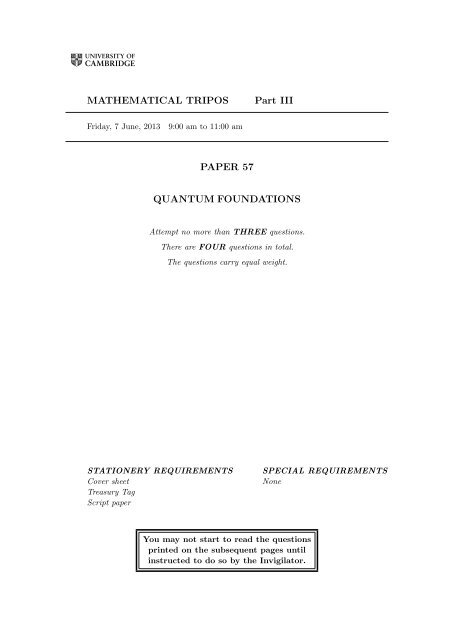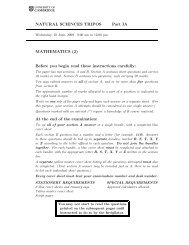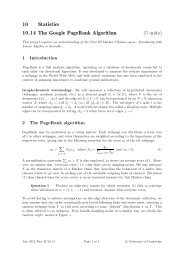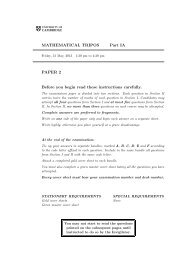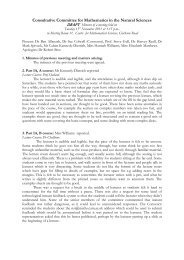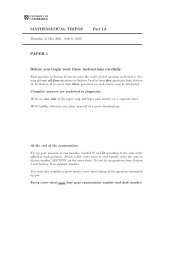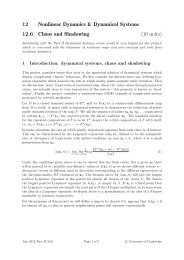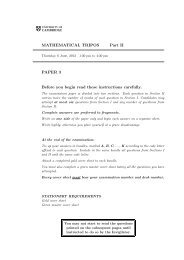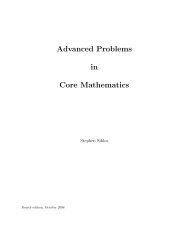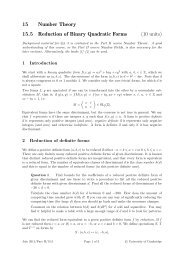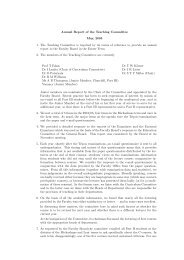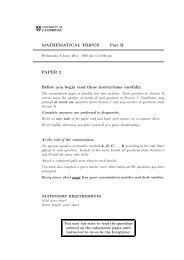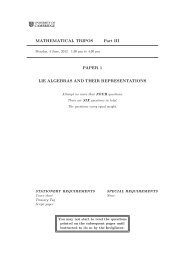MATHEMATICAL TRIPOS Part III PAPER 57 QUANTUM ...
MATHEMATICAL TRIPOS Part III PAPER 57 QUANTUM ...
MATHEMATICAL TRIPOS Part III PAPER 57 QUANTUM ...
Create successful ePaper yourself
Turn your PDF publications into a flip-book with our unique Google optimized e-Paper software.
<strong>MATHEMATICAL</strong> <strong>TRIPOS</strong><br />
<strong>Part</strong> <strong>III</strong><br />
Friday, 7 June, 2013 9:00 am to 11:00 am<br />
<strong>PAPER</strong> <strong>57</strong><br />
<strong>QUANTUM</strong> FOUNDATIONS<br />
Attempt no more than THREE questions.<br />
There are FOUR questions in total.<br />
The questions carry equal weight.<br />
STATIONERY REQUIREMENTS<br />
Cover sheet<br />
Treasury Tag<br />
Script paper<br />
SPECIAL REQUIREMENTS<br />
None<br />
You may not start to read the questions<br />
printed on the subsequent pages until<br />
instructed to do so by the Invigilator.
2<br />
1<br />
(a) The dynamics of a quantum particle of mass m moving in a potential V(r) is governed<br />
by the time-dependent Schrödinger equation<br />
i ∂ψ<br />
∂t = − 2<br />
2m ∇2 ψ +V(r)ψ. (1)<br />
(i) Write ψ(r,t) in terms of its modulus R(r,t) and phase S(r,t), and derive two<br />
non-linear differential equations for R and S.<br />
(ii) Explain the assumptions of the de Broglie-Bohm Pilot Wave Theory in the<br />
context of this problem. By imposing the guidance condition v = m∇S, where<br />
v = dr/dt is the velocity of the particle, use the result of (i) to show that<br />
d(mv)<br />
= −∇[V(r)+Q(R)], (2)<br />
dt<br />
where the form of Q is to be found explicitly.<br />
(b) A particle moves in two dimensions in a circularly symmetric potential. Consider<br />
time-independent Schrödinger equation<br />
− 2<br />
2m ∇2 ψ +V(r)ψ = Eψ. (3)<br />
(i) Working in plane polar coordinates (r,φ) separate (3) into the radial and angular<br />
parts, and show that the wave function of a stationary state has the form<br />
ψ = (2π) −1/2 f(r)exp[ikφ], where k is an integer and f(r) is a real function<br />
of r. [The wave function is normalized and single-valued.]<br />
(ii) Hence find the particle’s velocity (speed and direction) predicted by the de<br />
Broglie-Bohm theory.<br />
[ In polar coordinates ∇ 2 = 1 ( ) ( )<br />
∂<br />
r ∂r r<br />
∂<br />
∂r +<br />
1 ∂ 2<br />
, ∇· = ∂<br />
r 2 ∂φ 2 ∂r , 1 ∂<br />
r ∂φ , ∂ ∂z<br />
]<br />
<strong>Part</strong> <strong>III</strong>, Paper <strong>57</strong>
3<br />
2<br />
(a) State EPR’s criterion for identifying an element of physical reality and explain the<br />
assumptions of local hidden variables (LHV).<br />
(b) Consider an experiment in which two space-like separated parties, Alice and Bob,<br />
perform measurements on their local d-level systems, which interacted in the past.<br />
We assume that each party may choose one out of N different measurements, and<br />
that each measurement A k of Alice and B l of Bob (k,l = 1,...,N) may have d<br />
possible outcomes: A k ,B l = 0,...,d−1. The experiment is characterised by the joint<br />
probabilities P(A k = a,B l = b) that Alice’s and Bob’s measurement, A k and B l , have<br />
outcomes a and b respectively.<br />
Let [X] denote Xmodulod and<br />
〈X〉 = P (X = 1)+2P (X = 2)+...+(d−1)P (X = d−1)<br />
be the average value of the random variable X ∈ {0,...,d−1}.<br />
Show that the assumption of existence of a deterministic local hidden variables model<br />
for the correlations between the two systems implies that<br />
〈[A 1 −B 1 ]〉+〈[B 1 −A 2 ]〉+〈[A 2 −B 2 ]〉+...+〈[A N −B N ]〉+〈[B N −A 1 −1]〉 d−1. (1)<br />
(c) For the special case of d = 2 and N = 2 consider the quantum state<br />
where α and β are real amplitudes.<br />
|ψ〉 AB = α|00〉 AB +β|11〉 AB ,<br />
For projective measurements A 1 , A 2 , B 1 and B 2 in respective bases<br />
(|0〉 A , |1〉 A ),<br />
(<br />
cos π 4 |0〉 A +sin π 4 |1〉 A, sin π 4 |0〉 A −cos π )<br />
4 |1〉 A ,<br />
(<br />
cos π 6 |0〉 B +sin π 6 |1〉 B, sin π 6 |0〉 B −cos π )<br />
6 |1〉 B ,<br />
(<br />
sin π 6 |0〉 B +cos π 6 |1〉 B, cos π 6 |0〉 B −sin π )<br />
6 |1〉 B<br />
determine the condition, which α and β must satisfy in order for the measurement<br />
statistics to violate the inequality (1).<br />
<strong>Part</strong> <strong>III</strong>, Paper <strong>57</strong><br />
[TURN OVER
3<br />
4<br />
Alice and Bob (located at x A and x B respectively) share a maximally entangled<br />
state |Φ + 〉 d1 d 2<br />
= 1 √<br />
2<br />
(| ↑ z 〉 d1 | ↑ z 〉 d2 + | ↓ z 〉 d1 | ↓ z 〉 d2 ) of two spin- 1 2 particles d 1 and d 2 . In<br />
addition, they hold spin- 1 2<br />
particles A and B prepared in advance by a third party in an<br />
unknown state |ψ〉 AB . (In the following it is assumed that Alice and Bob each complete<br />
their local operations and measurements during time ∆t ≪ L/c, where L = |x A −x B |.)<br />
(a) Describe an explicit protocol which allows Alice and Bob to perform an instantaneous<br />
non-demolition verification that |ψ〉 AB is a state of zero z-component of the spin.<br />
(b) Write down the product eigenstates and eigenvalues of the operator<br />
(σ A z ⊗I B +I A ⊗σ B z )mod 4 (1)<br />
and use the result obtained in (a) to show how to perform an instantaneous nondemolition<br />
measurement of (1).<br />
(c) An operator on the tensor product H A ⊗H B has the following eigenstates<br />
|Φ + θ 〉 = cosθ| ↑ z↑ z 〉 AB +sinθ| ↓ z ↓ z 〉 AB<br />
|Φ − θ 〉 = sinθ| ↑ z↑ z 〉 AB −cosθ| ↓ z ↓ z 〉 AB<br />
|Ψ + θ 〉 = cosθ| ↑ z↓ z 〉 AB +sinθ| ↓ z ↑ z 〉 AB<br />
|Ψ − θ 〉 = sinθ| ↑ z↓ z 〉 AB −cosθ| ↓ z ↑ z 〉 AB ,<br />
(2)<br />
where 0 θ π/4. Consider a hypothetical instantaneous non-demolition measurement<br />
of this operator.<br />
(i) Show that the possibility of such operation would contradict relativistic causality<br />
unless θ = 0,π/4.<br />
(ii) Suggest and describe methods for realising such measurement in cases when<br />
θ = 0 and θ = π/4. [For θ = π/4 you may use the results obtained in parts (a)<br />
and (b). Assume that Alice and Bob share two maximally entangled states of<br />
the type |Φ + 〉 d1 d 2<br />
as a resource.]<br />
<strong>Part</strong> <strong>III</strong>, Paper <strong>57</strong>
5<br />
4<br />
Zurek’s decoherence model constitutes in a two-level measurement device D being<br />
monitored by a “bath” E of N spins via the interaction Hamiltonian<br />
H DE = −σ D z ⊗<br />
N∑<br />
g k σz,<br />
k<br />
where g k > 0 are coupling constants and σ z are Pauli matrices, which are defined with<br />
respect to the basis states of the device {|0〉, |1〉} and the spins {| ↑ k 〉, | ↓ k 〉} as their<br />
eigenstates.<br />
Initially, at t = 0, D is in the state a|0〉 D +b|1〉 D and the bath E is in the state<br />
which is normalized.<br />
|Ψ(0)〉 E =<br />
k=1<br />
N⊗<br />
(α k | ↑ k 〉+β k | ↓ k 〉),<br />
k=1<br />
(a) Calculate the reduced density matrix ρ D at t > 0 and show that off diagonal terms<br />
take the form ab ∗ z(t) and a ∗ bz ∗ (t), where z(t) is the decoherence factor. You should<br />
obtain an explicit expression for z(t). [You may assume = 1.]<br />
(b) Find z(t) for the case when all the spins are initially aligned along z-axis, that is when<br />
β k = 0 for all k. Hence deduce the value of |z(t)| 2 . Comment on this result.<br />
(c) Find z(t) for the case when all the spins initially lie in x−y plane.<br />
(i) For N = 3 and g 1 = π/2, g 2 = g 3 = π/4, sketch z(t) for 0 t 4. Comment.<br />
(ii) The coupling constants are uniformly independently distributed in the interval<br />
[0,a], a > 0. Show that for N ≫ 1, z(t) tends to zero with time. Comment.<br />
END OF <strong>PAPER</strong><br />
<strong>Part</strong> <strong>III</strong>, Paper <strong>57</strong>


